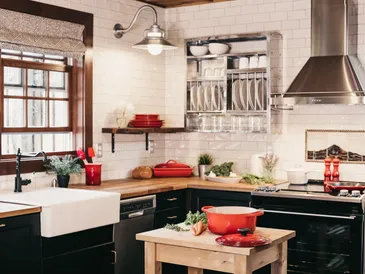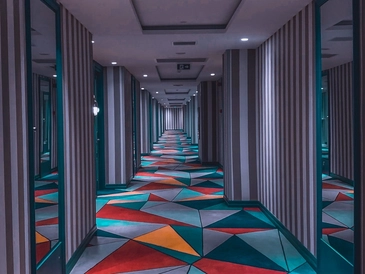Apt Interio specializes in designing modern home offices that blend functionality, style, and comfort to support today’s evolving remote work needs. Our approach emphasizes ergonomic furniture like adjustable desks and supportive chairs for maximum comfort. We integrate smart technology for seamless workflows, including voice-activated controls and organized cable management. Apt Interio incorporates biophilic elements such as natural light, indoor plants, and earthy tones to promote well-being.The home office has become a cornerstone of modern living, driven by the rise of remote work, freelance opportunities, and flexible working arrangements. Interior design and architecture practices for home offices focus on functionality, comfort, aesthetics, and productivity. Here’s a look at the latest trends and best practices shaping home office spaces today.

1. Ergonomic Furniture for Comfort and Productivity
A key focus in home office design is the health and comfort of the user, leading to a demand for ergonomic furniture that supports posture and minimizes strain. This includes:
- Adjustable Standing Desks: Allowing users to switch between sitting and standing positions.
- Ergonomic Chairs: Designed to provide back and lumbar support for extended sitting.
- Monitor Stands and Adjustable Arms: Promoting eye-level screen viewing to reduce neck strain.
Tip: Invest in ergonomic accessories like wrist rests, footrests, and anti-fatigue mats for added comfort.

2. Biophilic Design for Wellness and Creativity
Incorporating elements of nature into the home office can boost well-being and productivity. This trend features:
- Indoor Plants: Adding greenery to reduce stress and improve air quality.
- Natural Light Maximization: Positioning the desk near windows and using light, sheer curtains.
- Natural Materials and Colors: Wood, stone, and earthy tones create a calming, grounded ambiance.
Why it Works: Biophilic design helps to reduce stress, enhance creativity, and increase focus.

3. Smart and Tech-Integrated Workspaces
Smart home technology has permeated home offices, providing convenience and efficiency. This includes:
- Voice-Activated Assistants: Controlling lights, music, and reminders hands-free.
- Integrated Cable Management Systems: Keeping cords organized and out of sight.
- Wireless Charging Pads and Smart Plugs: Reducing clutter and optimizing space usage.
Tech integration ensures that home offices are highly functional and adaptable to modern workflows.

4. Personalized and Stylish Decor
A home office should reflect the user’s personality and taste, blending seamlessly with the rest of the home. Key practices include:
- Artwork and Decor Pieces: Inspiring visuals, motivational quotes, or personalized mementos.
- Accent Walls: Adding bold colors, wallpapers, or murals to create visual interest.
- Unique Lighting Fixtures: Pendant lights, desk lamps, or LED strips that blend functionality with style.
Pro Tip: Decorate with items that motivate or spark creativity while avoiding clutter.

5. Minimalist Design with a Focus on Decluttering
A clean, uncluttered space promotes focus and productivity. Minimalist home offices emphasize:
- Hidden Storage Solutions: Cabinets, drawers, and wall-mounted units to keep supplies organized.
- Streamlined Furniture: Clean lines and simple designs that reduce visual distractions.
- Neutral Color Palettes: Whites, greys, and beiges that foster a calm, organized environment.
Minimalist design ensures your home office is a place of focus and peace, free from unnecessary distractions.

6. Modular and Flexible Furniture Solutions
With home offices often doubling as multi-use spaces, modular furniture provides flexibility. This includes:
- Folding Desks: Easy to tuck away when not in use.
- Multi-Purpose Shelving Units: Acting as room dividers, storage, or display areas.
- Convertible Seating Options: Seating that can transform for different purposes, from work to relaxation.
Flexible furniture allows you to maximize functionality, even in limited space.

7. Soundproofing for Focus and Privacy
A productive home office minimizes distractions. Soundproofing solutions are increasingly popular and include:
- Acoustic Panels: Absorbing noise to create a quiet environment.
- Heavy Curtains and Rugs: Reducing sound reflection and external noise.
- Dedicated Home Office Doors: Providing physical separation from household noise.
This trend ensures greater focus, especially in busy households or when attending virtual meetings.

8. Home Office Pods and Dedicated Spaces
As remote work becomes more commonplace, dedicated home office spaces or pods are gaining popularity. This includes:
- Office Pods: Compact, enclosed spaces within a home for uninterrupted work.
- Repurposed Nooks: Transforming underutilized corners, closets, or alcoves into efficient workspaces.
- Garden Offices: Free-standing office structures in outdoor spaces for enhanced separation.
Dedicated spaces create clear boundaries between work and personal life, aiding work-life balance.

10. Color Psychology in Home Offices
Colors influence mood and productivity, with designers using color psychology to create an optimal working environment. Popular practices include:
- Calming Blues and Greens: Promoting focus and tranquility.
- Energetic Yellows and Oranges: Stimulating creativity and energy.
- Neutral and Light Tones: Minimizing distractions and creating a sense of order.
Choosing the right colors can positively impact concentration and overall well-being.

10. Indoor-Outdoor Living Connections
Bringing the outdoors in remains a strong design influence, especially in homes with access to outdoor spaces. This trend features:
- Sliding Glass Doors and Large Windows: To let in natural light and create visual continuity.
- Natural Ventilation: Enhancing airflow and indoor air quality.
- Outdoor-Inspired Decor: Using natural motifs, greenery, and organic shapes.
This approach blurs the boundaries between indoor and outdoor living, creating airy and refreshing spaces.
Tips for Designing Your Home Office
- Prioritize Ergonomics: Ensure comfort for prolonged work hours.
- Optimize Storage: Declutter with hidden storage solutions.
- Personalize for Inspiration: Add decor that reflects your taste.
- Focus on Lighting: Ensure a mix of natural and artificial light sources.
- Design for Flexibility: Adapt spaces for multiple uses when necessa
The modern home office blends style, comfort, and technology to meet the evolving needs of remote work and productivity. Whether focusing on ergonomic furniture, tech integration, or creating a calming environment, these design trends aim to enhance functionality, creativity, and overall well-being in home office spaces. Minimalist designs with hidden storage keep spaces clutter-free, while personalized decor and flexible modular furniture adapt to various needs.
